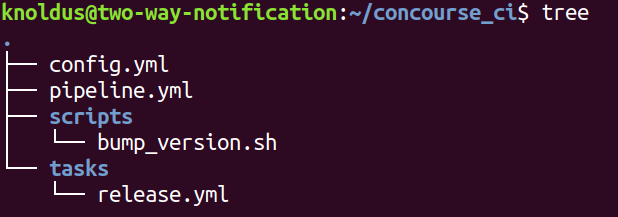

Concourse CI CD pipeline
source link: https://blog.knoldus.com/concourse-ci-cd-pipeline/
Go to the source link to view the article. You can view the picture content, updated content and better typesetting reading experience. If the link is broken, please click the button below to view the snapshot at that time.
In this blog, we are going to set up a typical CI/CD pipeline using concourse to make the development process more agile and deployment more visible.
The concourse is an open-source continuous thing-doer.
Built on the simple mechanics of resources, tasks, and jobs, Concourse presents a general approach to automation that makes it great for CI/CD.

Quick Start Concourse CI
There are many ways to setup concourse but in this blog, we are going to use the easiest way to setup concourse that is using docker-compose.
Download the docker-compose file
It contains a concourse server and PostgreSQL database for concourse backend.
wget https://concourse-ci.org/docker-compose.ymlRun that docker-compose file
docker-compose up -dThe concourse will be running at localhost:8080. You can log in with the username/password as a test/test.

fly CLI command-line tool
fly CLI is a command-line tool that you need to use to set up and manage pipelines on Concourse. We need to install fly CLI by downloading it from the web UI (localhost:8080). You can see in the above welcome page to download the CLI for windows, mac, and Linux.
After download the CLI tool we need to give execute permission to that and copy to the /usr/bin/
chmod +x flysudo cp fly /usr/bin/Next, set target your local Concourse as the test user:
fly -t tutorial login -c http://localhost:8080 -u test -p testNow you have successfully setup concourse on your local machine, let’s move to the CI/CD part.
Concourse Pipeline Directory structure
Concourse recomended directory structure.

Set up CI/CD
In this practical, we are going to deploy a spring boot application to the Kubernetes, Lets Start.
Clone the below repository
git clone https://github.com/azmathasan92/concourse-ci-cd.git
Go the to project root directory
cd concourse-ci-cd
Create a pipeline using a fly tool
Note: Before creating the pipeline we need to update the config.yml file to provide the docker and Kubernetes credentials.
Run the below command
fly -t tutorial set-pipeline -p spring-boot-service -c concourse_ci/pipeline.yml -l concourse_ci/config.ymlThe pipeline is configured now, and you can see that in the concourse UI.
When you create a new pipeline by default it is paused, so we need to unpause the pipeline, Run the below command to unpause the pipeline
fly -t tutorial unpause-pipeline -p spring-boot-service
Now, you have successfully created a CI/CD pipeline to the kubernetes.
Lets Understand pipeline.yml file
resource_types:
- name: kubectl-resource
type: docker-image
source:
repository: jmkarthik/concourse-kubectl-resource
tag: latest
resources:
- name: spring-boot-service
type: git
source:
uri: https://github.com/azmathasan92/concourse-ci-cd.git
branch: master
- name: spring-boot-service-docker-repository
type: docker-image
source:
email: ((docker-hub-email))
username: ((docker-hub-username))
password: ((docker-hub-password))
repository: ((docker-hub-username))/((docker-hub-repo-name))
- name: kubectl
type: kubectl-resource
source:
api_server_uri: ((server))
namespace: ((namespace))
certificate_authority_data: ((cad))
token: ((token))
jobs:
- name: test
public: true
plan:
- get: spring-boot-service
trigger: true
- task: mvn-test
file: "spring-boot-service/concourse_ci/tasks/maven-test.yml"
- name: package
public: true
serial: true
plan:
- get: spring-boot-service
trigger: true
passed: [test]
- task: mvn-package
file: "spring-boot-service/concourse_ci/tasks/maven-package.yml"
- put: spring-boot-service-docker-repository
params:
build: spring-boot-service-out
- name: deploy
public: true
serial: true
plan:
- get: spring-boot-service
trigger: false
passed: [package]
- put: kubectl
params:
file: "spring-boot-service/spring-boot-deploy.yaml"
In the above CI/CD pipeline, we are seeing the following components:
- Resource Type
Each resource in a pipeline has a type. The resource’s type determines what versions are detected, the bits that are fetched when the resource’s get step runs, and the side effect that occurs when the resource’s put step runs.
An exhaustive list of all resource types is available in the Resource Types catalog. - Resource
Resources are the heart and soul of Concourse. They represent all external inputs to and outputs of jobs in the pipeline. - Job
Jobs determine the actions of your pipeline. They determine how resources progress through it, and how the pipeline is visualized.
The most important attribute of a job is its build plan, configured as a job.plan. This determines the sequence of steps to execute in any builds of the job. - Task
The smallest configurable unit in a Concourse pipeline is a single task. A task can be thought of as a function from task.inputs to task.outputs that can either succeed or fail.
Resources:
Thank you for sticking to the end. If you like this blog, please do show your appreciation by giving thumbs-ups and share this blog and give me suggestions on how I can improve my future posts to suit your needs. Follow me to get updates on different technologies

Recommend
About Joyk
Aggregate valuable and interesting links.
Joyk means Joy of geeK